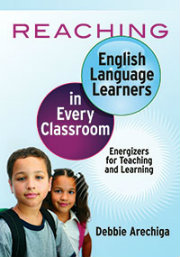Energize ELLs
Reaching English Language Learners in Every Classroom:
Energizers for Teaching and Learning
By Debbie Arechiga
(Eye on Education/Routledge, 2012 Learn more)
In her book Reaching English Language Learners in Every Classroom, Debbie Arechiga introduces herself as “a teacher’s teacher,” and I couldn’t agree more.
Individuals, not statistics
When I first began teaching, I fell in love with the young students housed in the classroom next door working with the English as a Second Language teacher and her young assistant. Now, working with pre-service teachers, I was excited to read this book in hopes of further understanding how my own students could assist their future English Language Learners. This book did not disappoint.

Energizers for teaching and learning
As I read the energizers she gives for teaching, I couldn’t’ help but think that many of the strategies would be beneficial for all students, not just the English Language Learners. Cultivating connections, connecting to colleagues, and connecting to culture united with the elevation of expectations are a worthy combination for any teacher; but when working with ELLs, the combination is especially powerful.
She describes literacy as being more than reading. The comprehensive literacy framework for which she advocates includes comprehension, active word study, real reading, writing, and purposeful conversations. When the framework of literacy is supercharged with the energizers, ELLs cannot help but benefit.
A non-verbal toolbox
Also valuable to teachers is a comprehensive section on how non-verbal messages can help or hinder in a classroom, especially one that includes ELLs. Non-verbals can be used to differentiate learning, and facial expressions can evoke emotion and make connections with students. Debbie points out that “a toolbox of gestures used in strategic ways will, in effect, sustain and create a language-rich environment for ELLS” (p. 106).
The text layout is reader-friendly and especially helpful for busy teachers. Succinct yet descriptive sidebars provide an overview of the information presented while an “in brief” at the end of each chapter provides the main points in a bulleted format.
Probably spurred by my love for using technology in ways that can enhance student learning, I do wish Debbie had included tips for technology integration. She mentions briefly that tech can be a valuable aid but offers no specifics for integrating its use into the pedagogy used when working with ELLs.
Keep process – not polish – in mind
As I concluded my reading, I was continually drawn to one of my favorite lines: “Keep process – not polish – in mind when helping ELLs negotiate their new language. Students will ‘use but confuse’ grammatical structures and proper usage while gaining command of a new language” (p. 153). Kudos to Debbie Arechiga for her practical and informative text!
After spending 25 years as a high school English teacher and district-level technology integrationist, Mary Churchill is currently an assistant professor of educational leadership at the University of Wisconsin, Superior. She holds a doctorate in education with research focused on instructional design for online learning and understanding how online learning can enhance learning opportunities for K-12 students. Mary lives in Duluth, MN, with her husband, two high school kids, and a neurotic dog.




































